Planeswalker's Guide to Return to Ravnica: Part 3
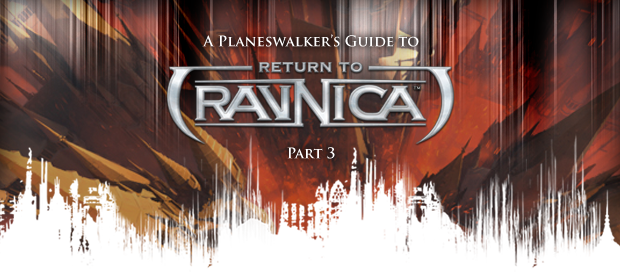
This is Part 3 of the Return to Ravnica Planeswalker's Guide. Part 1 introduced you to Ravnica and the Selesnya guild. Part 2 described the Izzet and Golgari guilds. The guide concludes today with the Azorius and Rakdos guilds.
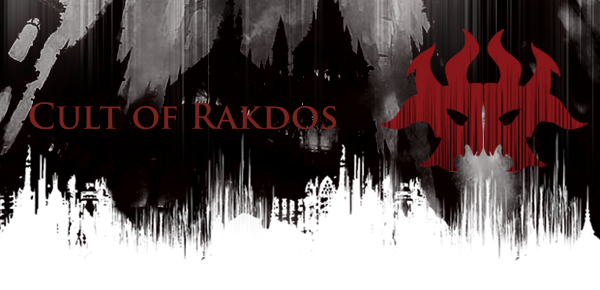
The Rakdos Cult is a large group of hedonists, sadists, criminals, and psychopaths under the leadership of a powerful demon named Rakdos. The Rakdos Cult combines a destructive urge with the desire for pleasure. Its members are sadistic and cruel simply for the fun of it. Extreme entertainments and personal enjoyment are their goals. They want Ravnica to bow to their whims and anything that gets in their way—or happens to be walking by—is fair game.
Rakdos the Defiler is the undisputed head of the guild, but beyond that, Rakdos lacks a formal structure. The cult members despise rules or anything that curtails their freedom, so there are no laws other than the precept to please their demonic master. They might attack each other on the street during the day and then go to the same revelry at night. On the surface, the activities of the guild are run by loosely affiliated "Rings," each led by a Ringmaster, and each with its own sphere of influence, commodities, and cult followers. Selfishness and hedonism guide cult members' actions, and there is little thought to consequences—ever. Members of Rakdos are driven by a desire to entertain themselves and they don't care who they hurt along the way.
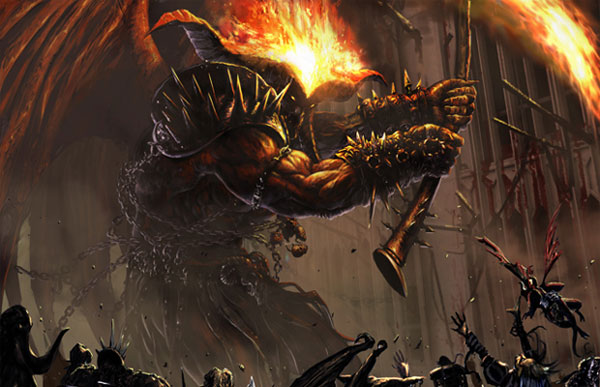
Art by Vincent Proce
Rakdos the Defiler has lived for thousands of years. When we last saw him, his unconscious body was dumped into his lava pit in Rix Maadi. But now, Rakdos has awakened and is restored to his full power. He's in complete control over the Cult of Rakdos, which is thriving and growing despite the low life expectancy of its members. While the proclivities of the cult members run the gamut between hedonism and destructive evil, Rakdos is at the far end of that spectrum. He embodies destructive evil, all in the context of twisted entertainment.
Rakdos's age and origins are unknown. He is capricious and megalomaniacal. He wants everything to happen on a grand scale. In one moment, he can be seen roaring with satisfaction at the sight of his performers. In the next moment, he might order they be set on fire while he laughs cruelly as they burn to death. He has an uncanny magnetism that draws people to him, and he rewards his followers by catering to their twisted desires. Carnage and carnal pleasures—these are the currencies of Rix Maadi.
When Rakdos is awake, he is the undisputed center of the attention. His whims are catered to, whether it is murder or mutilation, and nothing is spared to please the master. When Rakdos slumbers, which he does for days at a time, the cult members ratchet down the murder and chaos. Instead, the atmosphere in Rix Maadi becomes political and manipulative as the bloodwitches vie for control. Then Rakdos wakes up, and it's an orgy of bloodletting and mayhem again.
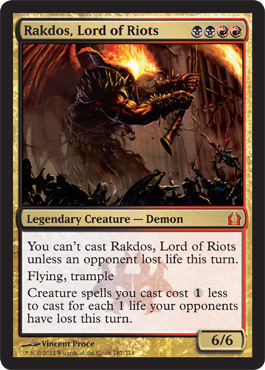
The Rings of Rakdos. The Rakdos Cult is made up of the Rings, which are shifting conglomerations of people who pay tribute to Rakdos in exchange for protection as well as cult membership. Membership in Rakdos is not a formal arrangement; it's a sense of acceptance, of shared deviance, and communal justification of amorality. Currently, there are nine major Rings of Rakdos, some more depraved than others, each one led by a minor cult leader called a Ringmaster who ultimately answers to Rakdos himself. The number of Rings is malleable, depending on the demands of the Ravnican public, Rakdos's whims, and the power plays of individual Ringmasters.
The Rings have territories based around the physical locations of their clubs, and they enforce their control over these territories with violence when necessary. Many Rings run multiple clubs within them, which sometimes only last weeks or months before they are shut down by a mass murder, major fire, or—sometimes—by the law enforcement of other guilds.
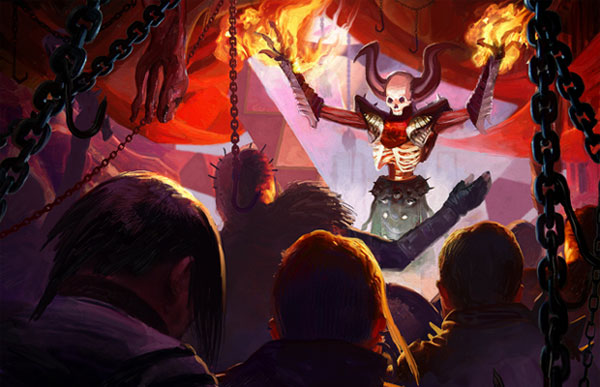
Art by Jason Felix
Diversion Clubs. Currently, there are five Rings that service Rakdos-affiliated diversion clubs. The clubs sell all manner of food and drink, twisted circus entertainment, bathhouse amenities, and creepy burlesque revues. The bulk of the Rakdos membership is involved in these diversion clubs as workers, performers, or hangers-on. Cult members tend to be young and live a nocturnal existence of revelries and petty crime. There's a lot of violence between cult members, as well as random "family" groups who live nomadic existences in squat houses throughout Ravnica. Most cult members live hard and die young.
Debauchery Clubs. Currently, there are three Rings that service debauchery clubs, which are usually higher on the depravity scale. These clubs offer a variety of entertainment, tattooing and scarring, pit fighting, and other services. Most do not have an obvious storefront that is recognizable by the general public. Those who wish to frequent them must either pay a high entrance fee or pay special tribute to Rakdos himself.
The Torturers. There is only one torture-oriented Ring, and that is located in the depths of Rix Maadi itself. Rakdos leaves this pain-inflicting "entertainment" up to bloodwitches and their masochistic minions and toadies. This is the most depraved Ring, with sacrificial murders both voluntary and involuntary. One of the caverns off the Lava Pit of Rix Maadi is filled with torture devices of all kinds.
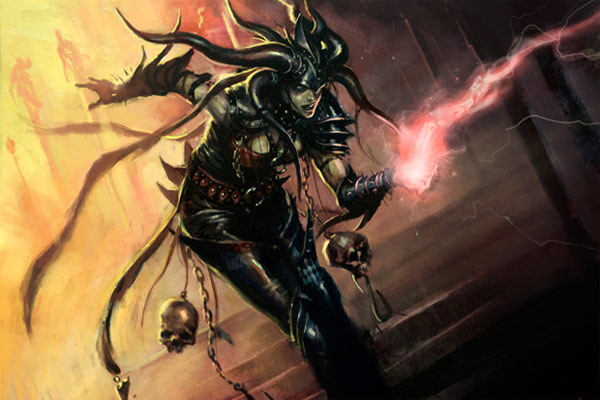
Rix Maadi Guildmage | Art by Karl Kopinski
Rix Maadi, the Dungeon Palace. Rakdos dwells inside Rix Maadi, a guildhall built around a lava pit in the undercity. The most direct route to Rix Maadi is down an immense stone staircase that leads down an ancient tunnel carved deep into the earth by a wurm and enforced with thick stone pillars. Rakdos members call this subterranean passage the Demon's Vestibule. The crumbling walls of the tunnel are covered in colorful banners and old bloodstains. These faded and ripped banners depict all manner of grotesque acts as well as promote diversion clubs and "festivals." This creates a dark carnival tone even before you reach Rix Maadi. As you descend into the undercity, the temperature rises. Everything is cast in a red glow from the veins of molten rock that branch across the walls and ground. Before Ravnica became covered in city, this section was a volcano. The top of the volcano was long ago stripped away and replaced by buildings, but the molten core and lava pits are still intact.
Rix Maadi stands at the far end of a courtyard, its ornate stone edifice flanked by jagged basalt pillars flowing with lava streams. Tattered cloth banners hang limply from metal spikes and ominous red light pours out through the giant doorway. The façade of Rix Maadi is the only part of the guildhall that resembles an actual building. Inside, Rix Maadi is a large natural cavern with a high ceiling where "chimneys" ventilate the immense underground chamber.
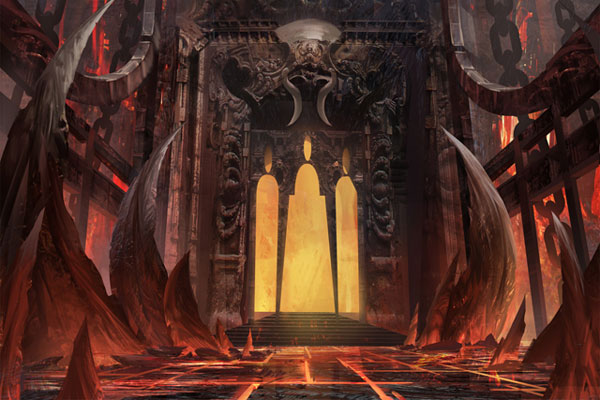
Rakdos Guildate | Art by Eytan Zana
The Festival Grounds. In front of Rix Maadi is a vast, derelict courtyard with a large, defaced fountain at its heart. In the center of the fountain, a once-beautiful statue of a rearing centaur is partially smashed and smeared with various substances. The courtyard looks like an acrobat troupe fled without bothering to pack up their equipment. A rickety tightrope is strung across the courtyard. Several trapezes dangle from rusty hooks. Human-size wooden cages lay tipped on their sides and discarded spiky tools with dubious functional use are scattered haphazardly. On closer inspection, everything is blood-splattered. This courtyard is the site of the most notorious—and fatal—Rakdos festivals.
Roles Within the Rakdos Guild
Riot Mage. These mages lead Rakdos festivals. They often have dramatic, chaotic personalities and colorful names that rival the pit fighters. They know how to put on a show and incite bystanders into joining the festivities. These festivals are dearly loved by Rakdos members and hated by the general public, who are left to clean up the rubble and hold the funerals afterwards. Rakdos festivals are not only a reward to cult members, but also a pretense for Rakdos thieves to steal anything they can get their hands on while the residents are distracted.
Bloodwitch. These are a cadre of powerful witches who reside in Rix Maadi and are the closest thing to advisors Rakdos has (or would ever tolerate). Exava currently wields the most power, although she has to work hard to keep it. Most of the political maneuvering that happens in the Rakdos cult happens among these witches, most of whom are female. Rakdos prizes chaos and cruelty, so the bloodwitches cultivate these qualities while downplaying their own aspirations for power and privilege.
Roustabout. These are the cult members who staff the diversion clubs and debauchery clubs or assist riot mages during festivals. A roustabout is any cult member who hangs around a club, helping out the Ringmaster with whatever tasks are needed, such as cleaning up blood spills or dragging the dead bodies out and leaving them in a gutter in another district. This is not a formal economic arrangement and a roustabout is usually compensated with something other than cash.
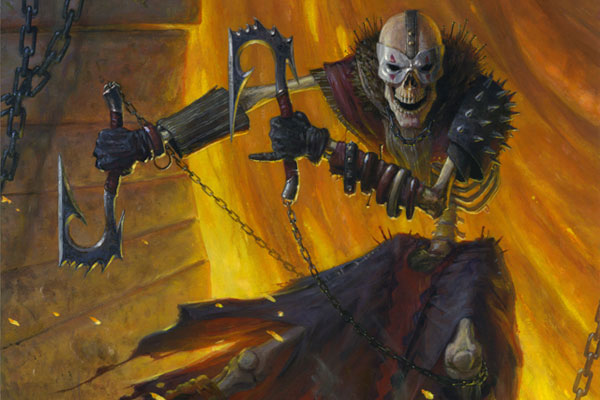
Grim Roustabout | Art by Steven Belledin
Spiker. The muscle of Rakdos. They got their name from a now-defunct group who killed their victims with spikes, usually through the mouth. Each Ringmaster employs spikers to handle any violence—whether it's controlling it or instigating it. Some of the spikers form gangs with their own hazing rituals. Fighting between spiker gangs is like a Rakdos spectator sport complete with betting and audience participation. Massacre Girl's spikers are particularly notorious for their random acts of violence. There are many ogres among the spikers. In addition to possessing incredible strength, they tend to be good followers, as they rarely show the capacity to think for themselves or even carry out complex orders.
Madcap. These are the entertainers of Rakdos. This nickname encompasses everyone from acrobats to cabaret dancers to gremlins on unicycles. Many of the madcaps are homicidal deviants whose acts involve gruesome killing displays masquerading as entertainment. Often, the madcaps are the smaller humanoids who couldn't survive in the Rakdos cult on their own, so they compensate by being "artistic." Being a good entertainer gives you enough capital to stay alive.
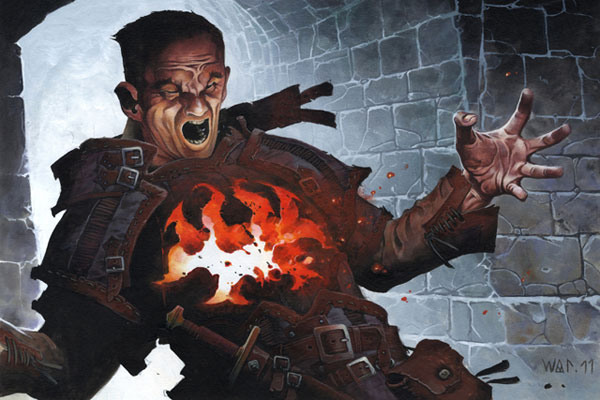
Dreadbore | Art by Wayne Renolds
Rakdos Attitudes Toward Other Guilds
Azorius: "How do you make an Azorius dance? Rip out his spine and make him into a marionette."
Boros: "The only thing angels are good for is target practice."
Dimir: "Not afraid to get their hands dirty, but they need to learn to enjoy life more."
Gruul: "Our poor, stupid cousins. There's more to life than scraps of leather and hunks of flesh. Or at least, more fun things than they use them for."
Golgari: "Anything that spends so much time around fungus should be put out of its misery."
Izzet: "Too stuffy, but making bigger and better explosions is a reasonable way to spend your time."
Selesnya: "Pampered dryads pretending to be selfless puts Rakdos in a very killing mood."
Simic: "Freaky brainiacs that mess with nature for all the wrong reasons."
Orzhov: "The only thing worse than a bunch of rules is a bunch of idiots with the power to force those rules on others. Power to Rakdos!"
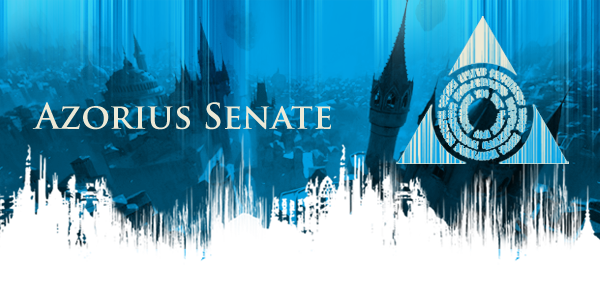
Also known as the High Judges, the Azorius Senate is Ravnica's ostensible government. The guild considers itself to be the mediator and controller of all other guilds' activities, even though most of its countless decrees are largely ignored. That's not to say the Azorius Senate is impotent, however—its legitimacy and reach wax and wane over time depending on economics, cultural trends, and the reaction to other guilds' overreach. At its best, the ultra-hierarchical Azorius Senate is just, farsighted, and impartial. At its worst, the guild is cold, stultifying, and bureaucratic.
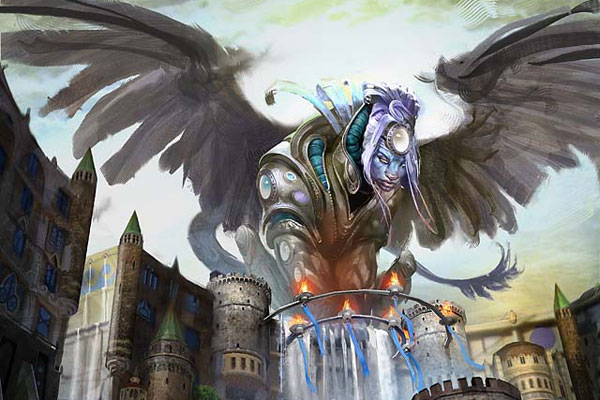
Isperia, Supreme Judge | Art by Scott M. Fischer
Azorius Guild Structure
Supreme Judge Isperia. The sphinx Isperia is the current guildmaster of the Azorius. The process of convincing Isperia to lead the guild took years, as sphinxes are aloof beings who value solitude above all. As crime and chaos on Ravnica increased in the absence of the Guildpact, however, and as its denizens more vocally demanded laws and their enforcement, Isperia decided her service was needed enough to trump her own preferences.
The Three Columns. The trias politica structure of the Azorius Senate has existed nearly since the beginning of the guild but had been theoretical and unimportant for millennia. With the dissolution of the Guildpact and the rebuilding of Prahv, the Azorius revivified the concept, and it has become deeply meaningful and reflective of the guild's structure and hierarchy.
- Sova Column. Comparable to a judiciary branch, this Column adjudicates, arbitrates, mediates, and studies the effects of Azorius law.
- Jelenn Column. This is the legislative part of the guild—the actual makers of law, including assessing the need for new laws and formulating their language.
- Lyev Column. Putting laws into practice, as well as enforcement of them, is the domain of the Lyev Column.
Roles Within the Azorius Guild
The guild's uses of magic tend to fall into three functions: establish, maintain, refine (or alternatively: build, defend, improve). Although these functions might seem to map cleanly to the Columns (Jelenn, Lyev, and Sova), all three functions find expression in all three Columns. Examples include:
Hussars and Infantry. The Azorius military, the vast majority of which belongs to the Lyev Column, can be broadly separated into mounted and unmounted soldiers. Mounted soldiers—whether they ride horses, griffins, or large beasts—are called hussars. Griffin-riders, for example, are sky-hussars. All unmounted troops are infantry. Azorius infantry are trained in line formations—phalanxes. Some phalanxes wield pikes, but the all-tower-shield phalanx, backed by mages, is a uniquely Azorius tactic used for crowd control.

Art by Seb McKinnon
Lawmages and Hieromancers. The paradigm shift in Azorius methodology—from laws enforced by magic to laws designed to be followed voluntarily—has made lawmages rarer. But some magic is still required to keep the day-to-day peace on Ravnica. Lawmages create spells that compel or restrain beings and serve a constabulary function in outlying districts. Hieromancers create spells that sanctify or protect places or things. They are called in only for larger-scale challenges, and sometimes to protect wealth.
Konstructors. Azorius builders and architects are among the best in the world, and konstructors are those who enhance and/or accelerate their building projects with magic. The scale and speed of the New Prahv project mandated a small army of guild konstructors. The sheer height of the towers would not have been possible without them.
Elocutors. The Azorius tendency to talk patiently and at length is valued not just within the guild but also by the citizenry and other guilds. The term elocutor covers all communication functions, from simple messengers—who are often spirits—to conflict mediation. Vedalken elocutors are particularly valued in complex negotiations involving resources or property. Human elocutors are favored for conflicts in which emotions run high. The very best of them subtly weave enchantment into dialogue to calm emotions and encourage cooperation.
Arresters. Arresters specialize in preventing or stopping things from happening. Although the Azorius mentality is different than it was in previous centuries, the guild still values the status quo and believes all action is ill-advised. ("Action is but reaction without thought," the Azorius saying goes.) Arresters come in all forms, from those whose purpose is to stop needless laws from being enacted to those who arrest criminals.
